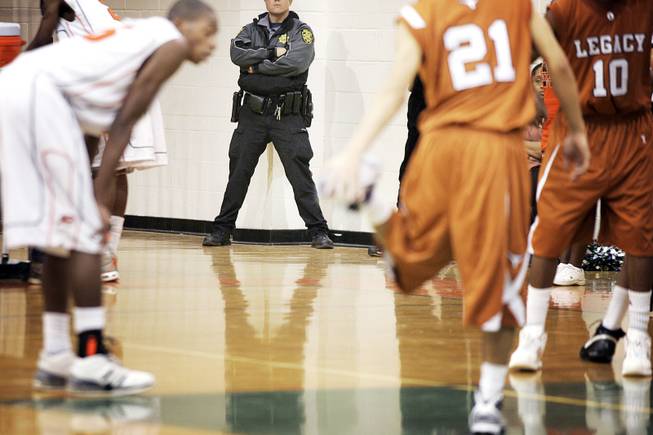
Legacy and Mojave high school basketball teams spar last week with a Clark County School Police officer providing security. The department’s overtime costs are down sharply this year over last year.
Monday, Dec. 14, 2009 | 2 a.m.
In Today's Sun
Sun Archives
- District dozen hit jackpot with overtime pay (1-7-2007)
- Taxpayers save, thanks to overtime crackdown (1-14-2008)
- Overtime total jumps again (8-3-2007)
- OT costs surge, point to taxes that could’ve been spent more wisely (4-15-2007)
- The advantage of public service (2-18-2007)
- Roofer super’s super riches: Bigger bucks than boss (9-28-2006)
- School district police made $1 million-plus in overtime (5-5-2004)
Sun Coverage
Below is a breakdown of how the five divisions that cost the School District the most in overtime in 2008 trimmed costs, and how that in turn is affecting the scope and quality of services to the education community:
Facilities
Overtime costs 2008: $6.69 million
Overtime costs through Nov. 18: $1.83 million
Decline: 73 percent
With less money and the loss of painters, gardeners and maintenance crews, the facilities division’s overtime costs have dropped significantly. But it’s not all cause for celebration. District officials say ignoring upkeep now might be cheaper, but it will cost more in the long run as small maintenance jobs evolve into more costly repairs and replacements.
The facilities division is understaffed in key areas, including landscaping, maintenance and painting. With less availability to use overtime, the backlog of work order requests from campuses has tripled in the past year.
“Sometime down the road, there will be a price to pay,” said Paul Gerner, the district’s associate superintendent of facilities. “If we continue to operate on a shoestring, we’ll see our facilities deteriorate. It’s a sad fact of the matter.”
School Police
Overtime costs 2008: $2,335,820
Overtime costs through Nov. 18: $1,475,243
Decline: 37 percent
As in previous years, the bulk of the overtime for School Police is generated by requests from individual schools for extra security at athletic events and after-hour activities. But included in the districtwide budget cuts is a 15 percent, or $1.7 million, reduction in athletic and extracurricular activities. That means a pared-down sports schedule and fewer requests for School Police.
Another factor: For the first time in recent memory, School Police has enough officers to cover nearly all day shifts. The officer roster stands at 170, which includes three people hired last week and six people completing academy training.
The department has hired 30 officers in the past 18 months, allowing School Police Chief Phil Arroyo to assign two officers to most high schools. The department had previously been logging more than 200 hours per week in internal overtime to cover afternoon and swing shifts. This year, after the successful push by Arroyo to boost hiring, the average is closer to 24 hours per week, department spokesman Lt. Ken Young said.
Finance & Operations
Overtime costs 2008: $1,667,640
Overtime costs through Nov. 18: $1,196,921
Decline: 28 percent
About 80 percent of the overtime in this division is generated by the transportation department. Food services makes up most of the remaining 20 percent.
Since 2008 the district has made “a concentrated effort” to streamline school bus routes to make them as efficient as possible and reduce driver overtime, said Jeff Weiler, the district’s chief financial officer. Supervisors are also better tracking routine maintenance to cut down on breakdowns and “call-outs” for replacement vehicles, both of which often require overtime.
In the food services division, if an employee is sick at one campus, a worker from another campus is brought in rather than assigning overtime to a co-worker at the campus.
Instruction Unit
Overtime costs 2008: $389,798
Overtime costs through Nov. 18: $319,036
Decline: 18 percent
Most of this overtime was earned by employees at campus sites for extra duties, such as staff training or attending evening events.
Technology Services
Overtime costs 2008: $363,863
Overtime costs through Nov. 18: $111,483
Decline: 69 percent
When a classroom computer breaks or a campus network goes down, schools put in a repair request. But with strict new limits on overtime, lower-priority work orders are now handled only during regular working hours, said Jhone Ebert, the district’s chief technology officer.
“Instead of it taking us three days to get the job done, schools might have to wait eight or even 10 days,” Ebert said. “Everyone has to be a little more patient.”
There will always be a need for overtime in her division, Ebert said. Certain technology projects require a school’s computers to be put out of service for a period of time, which means the jobs have to be done after hours or on weekends.

Join the Discussion:
Check this out for a full explanation of our conversion to the LiveFyre commenting system and instructions on how to sign up for an account.
Full comments policy